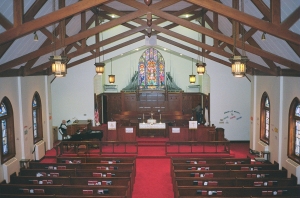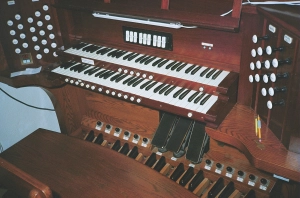
Aeolian-Skinner Organ, Opus 1175
1952, revised 1977-78 by Roy Perry and J. C. Williams
GREAT
16 Quintaten
8 Principal
4 Octave
2 2/3 Twelfth
2 Fifteenth
IV Fourniture
IV Cornet
ENCLOSED GREAT
8 Concert Flute
8 Flauto Dolce
8 Flute Celeste
4 Koppelflöte
8 Cromorne
Tremulant
SWELL
8 Gedackt
8 Viola
8 Viola Celeste
4 Principal
4 Rohrflöte
2 2/3 Nazard
2 Blockflöte
III-V Plein Jeu
16 Bassoon
8 Trompette
4 Clairon
Tremulant
8 Trompette-en-Chamade (Unenclosed)
PEDAL
16 Contre Basse
16 Gedackt (Sw.)
16 Quintaten (Gr.)
8 Spitz Principal
8 Gedackt (Sw.)
4 Choral Bass
III Mixture
16 Bassoon (Sw.)
St. Luke’s Church presents an exactly opposite set of conditions to those at First Baptist in Longview. Of a type all too common in the United States, the church is cozy and small, with a low pitched and padded roof, and a complete absence of “live” acoustical characteristics. The architect provided no organ space at all. The organ builder’s problems were manifold but not insurmountable, and, with the cooperation of a sympathetic and realistic committee, they have been solved with notable success.
The committee rejected a rather skimpy three-manual plan in favor of a very comprehensive two-manual. This wise choice put the maximum of available funds into pipes rather than mechanism, and gave the church the distinction of having one of the largest two manual organs in the world.
The usual snag in designing a two-manual organ for church use is in the matter of swell boxes. The great chorus suffers from enclosure as a rule, or else service playing is handicapped by the limitation of a single enclosed division. At St. Luke’s this difficulty is solved by a split great. The chorus is in the open as it should be, and visible; and the secondary Great voices, including a soft celeste and a color reed, are in a box.
The tonal aim was to produce a thoroughbred “Grand Orgue” effect, but on a miniature scale in keeping with the intimate character of the church. To avoid excessive loudness on the one hand and a tonal dryness on the other, with all elements in balance, is a severe test of an organ builder’s skill. By the use of moderate scales, low wind pressures, and very careful voicing techniques St. Luke’s organ has come off very well indeed. It is possible to use the full organ for hymns without complaints from the congregation; the organ is smooth and flexible for choral accompaniment; and there is hardly anything in organ literature that cannot be played with complete satisfaction.
The reed chorus is exceptionally good. A half-length Bassoon, a small scale Trompette, and an octave Hautbois provide three distinctive solo voices which unite into the intense band of tone essential to a proper Swell organ. A little gem of a mixture goes equally well with these and with the flue chorus on a broad Viola-Gedeckt base. An equally distinguished tone quality is present throughout the entire organ.
–Roy Perry, from a pamphlet he wrote describing the organ, together with those of First Presbyterian, Kilgore, and First Baptist, Longview, when the organs were new.

